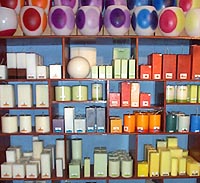| Simple
Candles to Make
This section contains information on some
simple methods of candlemaking.
Basics
Candlemaking, like
cooking, can be very simple or as complex as you want to make it!
Like cooking you need a few simple implements - pots or tins to melt
the wax in, a thermometer, a tray to catch wax spills, knife and scissors,
and some plastic containers for water baths. You don’t necessarily
need a double boiler with water or oil in it as the wax will melt
directly on a low flame. Don’t heat the wax over 90 degrees C
or it might start to smoke. A fan to ventilate the room is also a
good idea. You can get some recycled large metal tins from cafes which
are good if you want to have a few different colours. These hold about
3 kg of wax each. A metal candy thermometer is the best type to use
and these are available from catering stores.
Beeswax Candles
The simplest candles
to make are rolled beeswax candles. These are made by rolling a flat
sheet of beeswax tightly around a wick. It is important to make sure
that the wick is firmly in place. Shorter candles can by made by folding
the patterned sheets along a line and splitting them into thinner
sheets. Thicker candles can be made by rolling additional sheets around
thecandle until the desired size is reached.
Dipped Candles
A dipped candle
can be made by repeatedly dipping a piece of wick in wax until the
wax builds up on the wick and a candle forms. This can be sped up
by dipping it in water between wax dips thus cooling it. Alternately,
plain candles can be dipped in coloured and scented wax to change
their appearance, or the wax can be dripped or splattered on for interesting
effects. The extra wax on the outside of the candle will also increase
the burning time.
Dipped candles can also be
carved while warm and this gives an interesting effect if the candle
has previously been dipped in different coloured waxes. Dipping the
candle in water the final time it is dipped will give the candle a
shiny finish.
Moulded Candles
Moulded candles
are produced by pouring molten wax into a mould and letting it set.
Candle moulds are best but for starters you can use an old plastic
food container as a mould - even an aluminium can with the top cut
off will do. A hole needs to be drilled in the middle of the bottom
for the wick. The wick is attached at the bottom with some tape (ducting
tape works well and is available at hardware stores) and at the top
with a skewer or pencil. The wick should be firm so that it goes straight
down the centre of the candle. The seal on the bottom of the candle
must be airtight so that the wax doesn’t all run out the bottom
after pouring (every candle maker has done this!). The wick should
be primed by dipping it in molten wax and letting it set before wicking
the mould.
The wax is heated to about
90 degrees C and any colour or scent to be used added. If you are
using just paraffin wax add 10% stearin, more if beeswax is used.
This is important as the stearin will make the candle contract and
come out of the mould easily. The wax is poured into the mould and
the mould left to set. After some time check the candle - the wax
on top will most likely be contracting as it cools. A hole should
be made releasing the pressure and the indentation filled with some
hot wax. It may be necessary to do this 2 or so times.
The candle must be completely
cooled before any attempt is made to remove it from the mould otherwise
you risk pulling the wick out of it. You can also cool candles by
using a water bath. To do this the mould is placed in a plastic container
and weighted so that it doesn’t float or tip over. Once the wax
has been poured you fill the container with cold water. This speeds
up cooling and gives a good shiny consistent finish to the surface
of the candle. However, it is more difficult then air cooling and
more problems can arise such as water getting into the candle through
the wick hole.
Once the candle is completely
cooled it is removed from the mould and what was the bottom becomes
the top. The excess wick is trimmed. There are many variations on
this basic method such as pouring multiple layers in different colours
and putting wax chunks in before pouring the molten wax.
|
